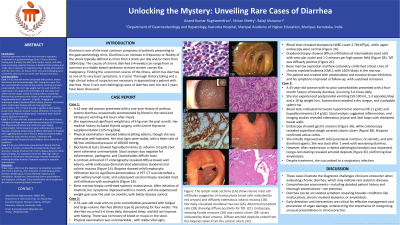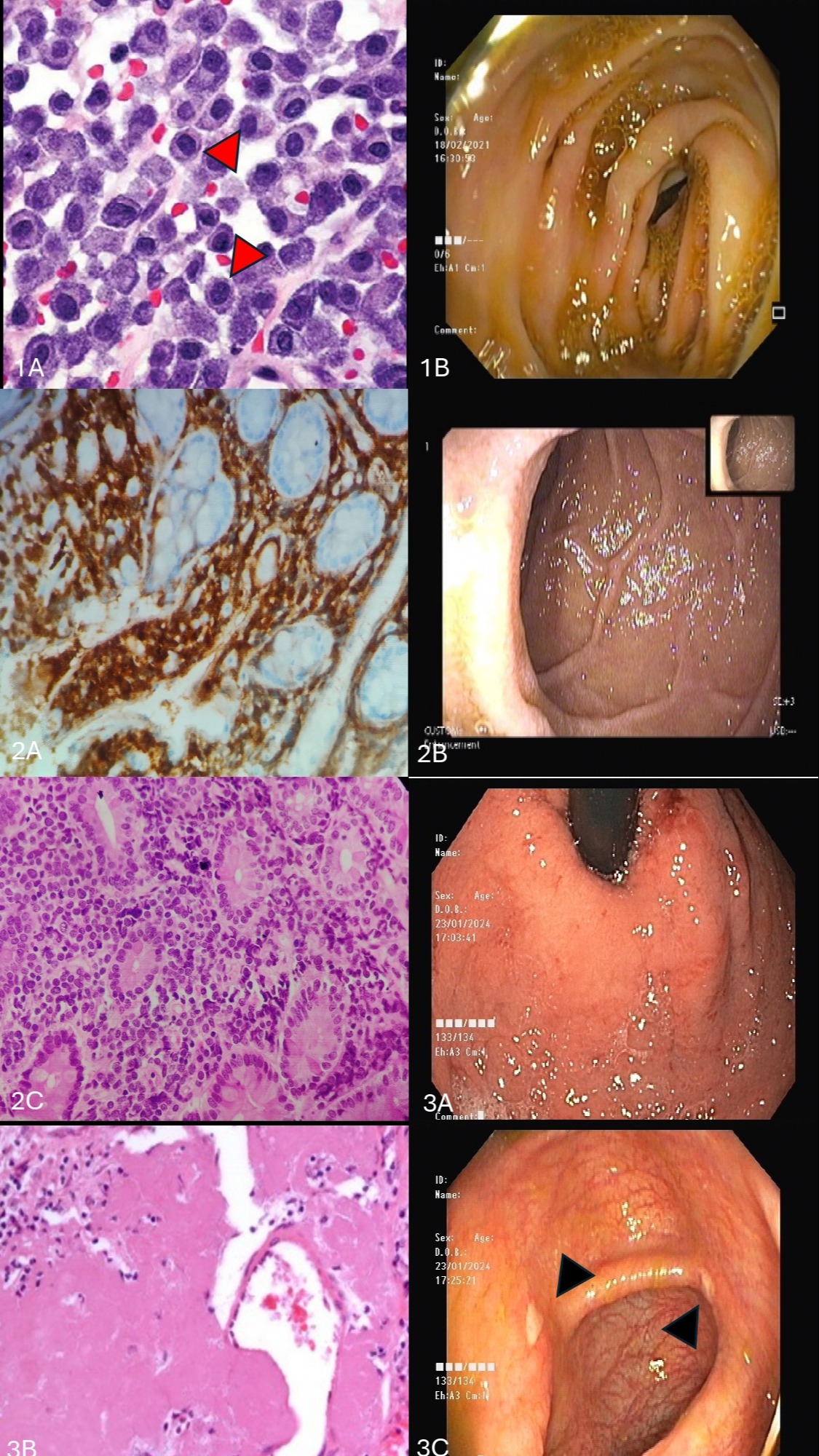Sunday Poster Session
Category: Small Intestine
P1567 - Unlocking the Mystery: Unveiling Rare Cases of Diarrhea
Sunday, October 27, 2024
3:30 PM - 7:00 PM ET
Location: Exhibit Hall E

Has Audio

Anand Kumar Raghavendran, MBBS, MD
Kasturba Medical College
Manipal, Udupi, Karnataka, India
Presenting Author(s)
Anand Kumar Raghavendran, MBBS, MD1, Shiran Shetty, MBBS, MD, DM1, Balaji Musunuri, MBBS, MD, DM2
1Kasturba Medical College, Manipal, Udupi, Karnataka, India; 2Kasturba Medical College, Udupi, Manipal, Karnataka, India
Introduction: Diarrhea represents one of the most prevalent symptoms encountered in gastroenterology clinics. Chronic diarrhea (lasting over 4 weeks) can stem from various causes, and often mask underlying systemic illnesses. A detailed history-taking and a high clinical suspicion is imperative when dealing with patients with diarrhea. Here, we discuss three rare and challenging cases of diarrhea observed over the past two years.
Case Description/Methods: Case 1: A 62-year-old woman presented with profuse, watery diarrhea to the Gastroenterology OPD, lasting for a year. This was associated with occasional low-volume vomiting 4-6 hours postprandially. She lost 6 kgs weight over the past month. On examination, she appeared comfortable and vital signs were within normal ranges, except for pitting edema in both legs. Biochemical parameters were mostly unremarkable, except for hypoalbuminemia (S. albumin- 3.0 g/dL). Imaging and endoscopic studies revealed diffuse edema, erosions and colonic ulcers. Endoscopic biopsies did not shows significant abnormalities. PET-CT done showed a significant right axillary lymph node. Biopsies showed massive infiltration of mast cells suggestive of Systemic Mastocytosis. Treatment with imatinib lead to significant response.
Case 2: A 53-year-old male presented with a four-week history of fatigue and large-volume diarrhea occurring up to 5-6 times a day. Physical examination and initial tests were largely unremarkable. Colonoscopy and upper endoscopy was normal. However, duodenal biopsy showed diffuse infiltration of myeloid cells suggesting blast crisis of Chronic Myeloid Leukemia (CML), confirmed by bone marrow analysis. Treatment with prednisolone and Tyrosine kinase inhibitors led to remission of symptoms.
Case 3: A 45-year-old female presented with bloody diarrhea lasting four months, occasionally accompanied by mucus and tenesmus. Despite treatment for Crohn’s disease based on initial biopsy findings, her symptoms worsened. With high clinical suspicion a review bone marrow biopsy revealed amyloidosis involving the bone marrow. Treatment resulted in symptom improvement.
Discussion: These cases underscore the diagnostic complexities associated with chronic diarrhea, often indicative of underlying systemic diseases. Mastocytosis, Chronic Myeloid Leukemia, and Amyloidosis, though rare, demonstrate diverse presentations and diagnostic challenges. Early identification and management are crucial in preventing organ damage and improving patient outcomes.

Disclosures:
Anand Kumar Raghavendran, MBBS, MD1, Shiran Shetty, MBBS, MD, DM1, Balaji Musunuri, MBBS, MD, DM2. P1567 - Unlocking the Mystery: Unveiling Rare Cases of Diarrhea, ACG 2024 Annual Scientific Meeting Abstracts. Philadelphia, PA: American College of Gastroenterology.
1Kasturba Medical College, Manipal, Udupi, Karnataka, India; 2Kasturba Medical College, Udupi, Manipal, Karnataka, India
Introduction: Diarrhea represents one of the most prevalent symptoms encountered in gastroenterology clinics. Chronic diarrhea (lasting over 4 weeks) can stem from various causes, and often mask underlying systemic illnesses. A detailed history-taking and a high clinical suspicion is imperative when dealing with patients with diarrhea. Here, we discuss three rare and challenging cases of diarrhea observed over the past two years.
Case Description/Methods: Case 1: A 62-year-old woman presented with profuse, watery diarrhea to the Gastroenterology OPD, lasting for a year. This was associated with occasional low-volume vomiting 4-6 hours postprandially. She lost 6 kgs weight over the past month. On examination, she appeared comfortable and vital signs were within normal ranges, except for pitting edema in both legs. Biochemical parameters were mostly unremarkable, except for hypoalbuminemia (S. albumin- 3.0 g/dL). Imaging and endoscopic studies revealed diffuse edema, erosions and colonic ulcers. Endoscopic biopsies did not shows significant abnormalities. PET-CT done showed a significant right axillary lymph node. Biopsies showed massive infiltration of mast cells suggestive of Systemic Mastocytosis. Treatment with imatinib lead to significant response.
Case 2: A 53-year-old male presented with a four-week history of fatigue and large-volume diarrhea occurring up to 5-6 times a day. Physical examination and initial tests were largely unremarkable. Colonoscopy and upper endoscopy was normal. However, duodenal biopsy showed diffuse infiltration of myeloid cells suggesting blast crisis of Chronic Myeloid Leukemia (CML), confirmed by bone marrow analysis. Treatment with prednisolone and Tyrosine kinase inhibitors led to remission of symptoms.
Case 3: A 45-year-old female presented with bloody diarrhea lasting four months, occasionally accompanied by mucus and tenesmus. Despite treatment for Crohn’s disease based on initial biopsy findings, her symptoms worsened. With high clinical suspicion a review bone marrow biopsy revealed amyloidosis involving the bone marrow. Treatment resulted in symptom improvement.
Discussion: These cases underscore the diagnostic complexities associated with chronic diarrhea, often indicative of underlying systemic diseases. Mastocytosis, Chronic Myeloid Leukemia, and Amyloidosis, though rare, demonstrate diverse presentations and diagnostic challenges. Early identification and management are crucial in preventing organ damage and improving patient outcomes.

Figure: Figure: The lymph node sections (1A) shows dense mast cell infiltrates suggestive of mastocytosis (Indicated by red arrows) and diffusely edematous colonic mucosa (1B). Abnormal lymphoid cells showing diffuse nuclear positivity for Tdt (40x) (2A and 2C) with normally visualised endoscopic Duodenum (2B). Diffuse amyloid deposits (3A) noted from the biopsies taken from the colonic ulcers (3C: Indicated by black arrow) and fundal erosions (3B).
Disclosures:
Anand Kumar Raghavendran indicated no relevant financial relationships.
Shiran Shetty indicated no relevant financial relationships.
Balaji Musunuri indicated no relevant financial relationships.
Anand Kumar Raghavendran, MBBS, MD1, Shiran Shetty, MBBS, MD, DM1, Balaji Musunuri, MBBS, MD, DM2. P1567 - Unlocking the Mystery: Unveiling Rare Cases of Diarrhea, ACG 2024 Annual Scientific Meeting Abstracts. Philadelphia, PA: American College of Gastroenterology.
